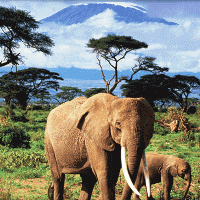 Nestled in the heart of Kenya, straddling the equator, National Park in Mt Kenya is a majestic testament to the raw, unbridled beauty of nature. Often overshadowed by the more renowned Maasai Mara and Amboseli National Parks, this hidden gem offers a unique blend of astonishing biodiversity, dramatic landscapes, and profound cultural significance. As Kenya's second-highest peak, Mount Kenya not only challenges the adventurous spirit of climbers but also serves as a sacred symbol to the communities living around it. We seek to unveil the wonders of National Park, inviting travelers and nature enthusiasts to explore its lesser-known facets. The park's allure is not merely in its towering summit, which reaches an impressive 5,199 meters above sea level, but in the diverse ecosystems that flourish in its shadow. From dense bamboo forests to alpine meadows, and from the stark, mineral-rich moorlands to the glacial valleys, the park is a microcosm of ecological diversity. Each zone offers a sanctuary for a myriad of flora and fauna, some of which are endemic to the region, such as the Mount Kenya bush viper and the giant groundsel. Beyond its natural beauty, the National Park is steeped in cultural lore. The Kikuyu, Embu, and Meru communities regard the mountain as a sacred entity, a realm of their gods and ancestors. This spiritual significance adds a rich layer of mystique to the visitor's experience, blending the physical trek with a journey through time and belief. For those in search of tranquility, adventure, and a deep connection with nature, National Park offers an unrivaled destination. Below is a guide for you through its hidden trails, uncover its secret wildlife havens, and share the stories of those who call this extraordinary place home. Join us as we embark on a journey to uncover the hidden wonders of Mount Kenya wildlife, where every path leads to discovery and every vista tells a story.
Nestled in the heart of Kenya, straddling the equator, National Park in Mt Kenya is a majestic testament to the raw, unbridled beauty of nature. Often overshadowed by the more renowned Maasai Mara and Amboseli National Parks, this hidden gem offers a unique blend of astonishing biodiversity, dramatic landscapes, and profound cultural significance. As Kenya's second-highest peak, Mount Kenya not only challenges the adventurous spirit of climbers but also serves as a sacred symbol to the communities living around it. We seek to unveil the wonders of National Park, inviting travelers and nature enthusiasts to explore its lesser-known facets. The park's allure is not merely in its towering summit, which reaches an impressive 5,199 meters above sea level, but in the diverse ecosystems that flourish in its shadow. From dense bamboo forests to alpine meadows, and from the stark, mineral-rich moorlands to the glacial valleys, the park is a microcosm of ecological diversity. Each zone offers a sanctuary for a myriad of flora and fauna, some of which are endemic to the region, such as the Mount Kenya bush viper and the giant groundsel. Beyond its natural beauty, the National Park is steeped in cultural lore. The Kikuyu, Embu, and Meru communities regard the mountain as a sacred entity, a realm of their gods and ancestors. This spiritual significance adds a rich layer of mystique to the visitor's experience, blending the physical trek with a journey through time and belief. For those in search of tranquility, adventure, and a deep connection with nature, National Park offers an unrivaled destination. Below is a guide for you through its hidden trails, uncover its secret wildlife havens, and share the stories of those who call this extraordinary place home. Join us as we embark on a journey to uncover the hidden wonders of Mount Kenya wildlife, where every path leads to discovery and every vista tells a story.
Some of the Most Popular Mt. Kenya National Park Attraction Sites
The Majestic Peaks of Batian and Nelion
While Point Lenana is a popular destination for trekkers due to its accessibility, the twin peaks of Batian and Nelion offer a challenge to serious mountaineers. These peaks are the highest on Mount Kenya and require technical climbing skills to the summit. The reward for this challenging ascent is the unparalleled panoramic views and the sense of accomplishment that comes with reaching the top of Kenya's highest points.
Lake Michaelson and Lake Alice
Tucked away in the folds of the mountain, these glacial lakes are a sight to behold. Lake Michaelson, in particular, is renowned for its stunning beauty, deep blue waters, and the sheer cliffs that cradle it. A trek to these lakes not only offers a chance to witness these tranquil waters but also to encounter rare wildlife and exotic alpine flora that thrive in this ecosystem.
The Gorges Valley
The Gorges Valley is a dramatic landscape feature that showcases the geological history of Mount Kenya. Trekking through this valley, visitors can marvel at the towering cliffs, rock spires, and the diverse vegetation that changes with the altitude. This area is less frequented by tourists, offering a serene and untouched environment for those looking to immerse themselves in nature.
The Bamboo and Alpine Forests
The Park is home to unique vegetation zones, including dense bamboo forests and the ethereal alpine forests. These ecosystems are not only vital for the local wildlife but also offer hikers a variety of landscapes to explore. Walking through these forests, one can encounter endemic species such as the Mount Kenya bush viper and the elusive bongo antelope.
Indigenous Cultural Heritage
The Kikuyu people, who live around the base of Mount Kenya, regard the mountain as a sacred place. Exploring the park with a local guide provides an opportunity to learn about the mountain's significance in Kikuyu folklore and its role in their spiritual and daily lives. This cultural aspect adds a rich layer to the natural beauty of the park.
Conservation Efforts
The National Park is at the forefront of conservation efforts in Kenya. The park's management works tirelessly to protect its biodiversity and ecosystems. By visiting, tourists contribute to these conservation efforts, ensuring that the park remains a haven for wildlife and a natural heritage site for future generations.
Adventure Awaits
Whether you're an avid trekker, a nature lover, or someone looking to explore off-the-beaten-path destinations, the National Park on Mount Kenya offers an adventure like no other. Its hidden gems are a testament to the park's diverse attractions, waiting to be discovered by those willing to venture beyond the ordinary.
The Park is a world of wonders that goes beyond the snow-capped peak that dominates its skyline. Its hidden gems offer an intimate encounter with nature, challenging adventures, and a deep connection with the cultural heritage of the local communities. As you plan your next adventure, consider unveiling the wonders of Mount Kenya, a journey that promises to be both exhilarating and enlightening.
In the embrace of Mount Kenya National Park, nature reveals its untold stories through a tapestry of biodiverse ecosystems, ancient forests, and majestic peaks. This hidden gem offers more than just scenic beauty; it's a sanctuary where wildlife thrives and ancient glaciers whisper the earth's secrets. As we peel back the layers of this magnificent destination, we uncover the essential role it plays in conservation and the profound impact it has on those who venture into its heart. The National Park on Mount Kenya is not just a place to visit, but a wonder to be preserved, cherished, and experienced deeply. In unveiling its wonders, we find a deeper connection to the planet and a reminder of the wild's enduring call.
Eco-Tourism in Mount Kenya - Preserving Nature's Majesty
 In Mount Kenya eco-tourism is not just an adventure; it's a profound journey into the heart of one of Africa's most splendid natural wonders. Mount Kenya, the continent's second-highest peak, rises majestically from the Kenyan highlands, offering breathtaking landscapes, diverse ecosystems, and a rare glimpse into the delicate balance of nature. This majestic mountain, a UNESCO World Heritage site, embodies the essence of eco-tourism, where conservation efforts and sustainable travel practices converge to preserve its pristine beauty for generations to come. The allure of Mount Kenya extends beyond its soaring peaks and glacial valleys. It is a vital water tower for the region, supporting agriculture and providing life-sustaining resources to the communities that surround it. The diverse habitats, ranging from dense forests to alpine meadows, are home to a rich variety of flora and fauna, including endangered species such as the Mount Kenya antelope and the elusive bongo. Eco-tourism initiatives in Mount Kenya aim to protect these natural treasures while offering visitors a unique opportunity to connect with nature in an impactful and respectful manner. Engaging in eco-tourism on Mount Kenya means embarking on guided treks that follow low-impact trails, staying in eco-friendly accommodations, and participating in conservation activities that contribute to the preservation of the ecosystem. These experiences are designed to educate travelers about the importance of environmental stewardship, highlighting the role each individual plays in safeguarding the planet's natural heritage. As the world becomes increasingly aware of the need for sustainable travel, Mount Kenya stands as a beacon of hope and a model for eco-tourism. It invites adventurers, nature lovers, and conservationists alike to witness the majesty of the natural world, untouched and unspoiled. In doing so, eco-tourism in Mount Kenya not only enhances the visitor's experience but also ensures that the mountain's majestic beauty remains intact, a lasting testament to the power of preservation.
In Mount Kenya eco-tourism is not just an adventure; it's a profound journey into the heart of one of Africa's most splendid natural wonders. Mount Kenya, the continent's second-highest peak, rises majestically from the Kenyan highlands, offering breathtaking landscapes, diverse ecosystems, and a rare glimpse into the delicate balance of nature. This majestic mountain, a UNESCO World Heritage site, embodies the essence of eco-tourism, where conservation efforts and sustainable travel practices converge to preserve its pristine beauty for generations to come. The allure of Mount Kenya extends beyond its soaring peaks and glacial valleys. It is a vital water tower for the region, supporting agriculture and providing life-sustaining resources to the communities that surround it. The diverse habitats, ranging from dense forests to alpine meadows, are home to a rich variety of flora and fauna, including endangered species such as the Mount Kenya antelope and the elusive bongo. Eco-tourism initiatives in Mount Kenya aim to protect these natural treasures while offering visitors a unique opportunity to connect with nature in an impactful and respectful manner. Engaging in eco-tourism on Mount Kenya means embarking on guided treks that follow low-impact trails, staying in eco-friendly accommodations, and participating in conservation activities that contribute to the preservation of the ecosystem. These experiences are designed to educate travelers about the importance of environmental stewardship, highlighting the role each individual plays in safeguarding the planet's natural heritage. As the world becomes increasingly aware of the need for sustainable travel, Mount Kenya stands as a beacon of hope and a model for eco-tourism. It invites adventurers, nature lovers, and conservationists alike to witness the majesty of the natural world, untouched and unspoiled. In doing so, eco-tourism in Mount Kenya not only enhances the visitor's experience but also ensures that the mountain's majestic beauty remains intact, a lasting testament to the power of preservation.
Some of the Sustainable Practices in Eco-Tourism on Mt Kenya
Eco-tourism on Mt. Kenya represents a beacon of sustainable travel, blending the allure of one of Africa’s highest peaks with a commitment to environmental stewardship and community development. As travelers become increasingly conscious of their ecological footprint, Mt. Kenya emerges as a prime example of eco-tourism done right. Here are six sustainable practices that highlight this commitment:
Minimizing Environmental Impact: Trekking and camping on Mt. Kenya are conducted under strict guidelines to minimize human impact. Trails and campsites are designed to limit erosion and habitat disruption, and visitors are encouraged to carry out all waste. The use of single-use plastics is discouraged, with many tour operators providing refillable water containers.
Supporting Local Communities: Eco-tourism on Mt. Kenya directly benefits local communities through employment opportunities as guides, porters, and eco-lodges. These roles not only provide a livelihood but also empower locals to become stewards of their environment. Additionally, a portion of park fees is allocated to community projects, ensuring that tourism has a positive ripple effect.
Wildlife Conservation Efforts: The region around Mt. Kenya is rich in biodiversity. Conservation projects, often funded by eco-tourism revenues, focus on protecting endangered species and their habitats. Efforts include anti-poaching patrols and community education programs to promote coexistence with wildlife.
Promoting Cultural Heritage: Visitors have the opportunity to learn about the Kikuyu people, among other local communities, for whom Mt. Kenya holds spiritual significance. Cultural tours and interactions are conducted in a respectful manner that honors local traditions and provides authentic insights into the lives of indigenous peoples.
Sustainable Lodging Options: Eco-lodges and campsites on Mt. Kenya prioritize sustainability through solar power, rainwater harvesting, and organic gardening. These facilities often blend seamlessly with the natural surroundings, offering minimalistic comfort without detracting from the mountain’s beauty.
Educational Programs: Eco-tourism operators on Mt. Kenya place a strong emphasis on education, offering guided tours that inform visitors about the local ecosystem, conservation challenges, and the importance of sustainability. This educational aspect enriches the visitor experience and fosters a deeper appreciation for natural and cultural heritage.
Eco-tourism on Mt. Kenya showcases how responsible travel practices can enhance the visitor experience while safeguarding natural and cultural resources for future generations. Through these sustainable practices, Mt. Kenya stands as a model for eco-tourism globally, demonstrating that adventure and environmental conservation can go hand in hand.
The Role of Local Communities in Mount Kenya Eco-Tourism
The role of local communities in Mount Kenya eco-tourism is pivotal, weaving a rich tapestry of cultural heritage and environmental stewardship that forms the cornerstone of sustainable tourism in the region. Nestled at the heart of Kenya, Mount Kenya is not only a natural wonder but also a cultural landmark, where the local communities, including the Kikuyu, Meru, and Embu tribes, play an integral role in eco-tourism. These communities are the custodians of the mountain’s ecosystems and rich biodiversity, implementing traditional knowledge and practices passed down through generations to conserve the environment. Their involvement in eco-tourism extends beyond conservation efforts to include active participation in the eco-tourism economy as guides, porters, and eco-lodge operators, providing authentic experiences that highlight the symbiotic relationship between humans and nature. Through such engagement, local communities ensure that eco-tourism practices on Mount Kenya are sustainable and beneficial to both the environment and the people. They are instrumental in educating tourists about the significance of the mountain, not only in terms of its breathtaking landscapes and wildlife but also its cultural and spiritual importance. This education fosters a deeper understanding and appreciation among visitors, encouraging responsible tourism practices that respect the natural habitat and cultural values. Moreover, by channeling a portion of the revenues generated from eco-tourism back into community projects, such as schools and healthcare facilities, the model promotes socioeconomic development while ensuring the long-term sustainability of the region's natural resources. In essence, the involvement of local communities in Mount Kenya eco-tourism is a testament to the power of collective action in achieving sustainable tourism that honors both the earth and its inhabitants, setting a benchmark for eco-tourism initiatives worldwide.
In the shadow of Mount Kenya, eco-tourism shines as a beacon of hope, marrying the desire for adventure with the imperative of conservation. As travelers seek to tread lightly on the earth, this majestic peak offers a powerful reminder of nature's vulnerability and resilience. By embracing sustainable practices, visitors contribute to preserving the unique biodiversity and cultural heritage of the region. The future of eco-tourism in Mount Kenya is not just about safeguarding a stunning natural wonder; it's about forging a harmonious relationship with our planet. In doing so, we ensure that future generations can also witness the majesty of Mount Kenya, a testament to the enduring spirit of conservation.
Wildlife of Mt Kenya National Park – From Elephants to Birds
 Mount Kenya National Park, a UNESCO World Heritage Site, is an emblematic feature of the Kenyan landscape, not only for its breathtaking vistas and the challenge it presents to climbers but also for the rich tapestry of biodiversity it supports. Nestled in the heart of Kenya, just south of the equator, this majestic mountain rises to an imposing height of 5,199 meters (17,057 feet), making it the second-highest peak in Africa after Mount Kilimanjaro. Its slopes and surrounding environments offer a microcosm of ecological diversity, ranging from lush montane and bamboo forests to high-altitude alpine meadows, each layer hosting a unique assembly of wildlife species that have adapted to the varying conditions and altitudes of the mountain. The wildlife of the National Park in Mount Kenya is as varied as the landscapes it inhabits. From the forested lower slopes where elephants roam through dense vegetation, creating paths in their wake, to the higher altitudes where specialized species such as the Mount Kenya hyrax and the elusive bongo make their home, the park is a haven for wildlife enthusiasts. Birdwatchers are particularly drawn to this area, where over 130 bird species have been recorded. The park's avian inhabitants range from the regal crowned eagle, soaring high above the canopy in search of prey, to the vibrant sunbirds flitting among the alpine flowers, their iridescent plumage a splash of color against the green backdrop. We aim to explore the incredible biodiversity of the National Park, focusing on the remarkable array of wildlife, from the majestic elephants that traverse its lower forests to the myriad of bird species that adorn its skies and landscapes. It will dig into the unique adaptations these creatures have developed to thrive in the varying environments of the mountain, offering readers a glimpse into the lives of these species and the ongoing conservation efforts to protect this unique ecosystem. As we journey through the Wildlife of Mt Kenya National Park, we uncover the intricate web of life that makes this region one of Africa's most splendid natural wonders.
Mount Kenya National Park, a UNESCO World Heritage Site, is an emblematic feature of the Kenyan landscape, not only for its breathtaking vistas and the challenge it presents to climbers but also for the rich tapestry of biodiversity it supports. Nestled in the heart of Kenya, just south of the equator, this majestic mountain rises to an imposing height of 5,199 meters (17,057 feet), making it the second-highest peak in Africa after Mount Kilimanjaro. Its slopes and surrounding environments offer a microcosm of ecological diversity, ranging from lush montane and bamboo forests to high-altitude alpine meadows, each layer hosting a unique assembly of wildlife species that have adapted to the varying conditions and altitudes of the mountain. The wildlife of the National Park in Mount Kenya is as varied as the landscapes it inhabits. From the forested lower slopes where elephants roam through dense vegetation, creating paths in their wake, to the higher altitudes where specialized species such as the Mount Kenya hyrax and the elusive bongo make their home, the park is a haven for wildlife enthusiasts. Birdwatchers are particularly drawn to this area, where over 130 bird species have been recorded. The park's avian inhabitants range from the regal crowned eagle, soaring high above the canopy in search of prey, to the vibrant sunbirds flitting among the alpine flowers, their iridescent plumage a splash of color against the green backdrop. We aim to explore the incredible biodiversity of the National Park, focusing on the remarkable array of wildlife, from the majestic elephants that traverse its lower forests to the myriad of bird species that adorn its skies and landscapes. It will dig into the unique adaptations these creatures have developed to thrive in the varying environments of the mountain, offering readers a glimpse into the lives of these species and the ongoing conservation efforts to protect this unique ecosystem. As we journey through the Wildlife of Mt Kenya National Park, we uncover the intricate web of life that makes this region one of Africa's most splendid natural wonders.
Mount Kenya National Park Activities - An Unforgettable Experience
Nestled in the heart of Kenya, National Park in Mt. Kenya offers an array of activities that promise an unforgettable experience for adventurers and nature lovers alike. This majestic mountain, the second highest in Africa, is not only a sight to behold but a playground for those seeking to immerse themselves in the beauty and diversity of the natural world. Here are six activities that make a visit to national park in Mt. Kenya an experience of a lifetime:
Mountain Climbing: For the adventurous at heart, scaling the peaks of Mt. Kenya provides a thrilling challenge. With routes like Naromoru, Sirimon, and Chogoria, climbers of varying abilities can find a path that suits them, offering breathtaking views and the satisfaction of conquering one of Africa’s highest mountains.
Hiking and Nature Walks: The park offers numerous trails that cater to all fitness levels, allowing visitors to enjoy stunning landscapes, from montane forests to bamboo thickets and alpine meadows. These walks are perfect for bird watchers and those interested in the rich plant life.
Wildlife Safaris: While the mountain is the main attraction, the surrounding national park is teeming with wildlife. Safaris provide a chance to see elephants, buffaloes, leopards, and a variety of antelope species in their natural habitat.
Bird Watching: With over 130 bird species recorded, Mt. Kenya is a haven for bird enthusiasts. The diverse ecosystems offer opportunities to spot rare and endemic species, including the scarlet-tufted malachite sunbird and the Alpine swift.
Camping: For those who wish to fully immerse themselves in nature, camping within the park is an unparalleled experience. Falling asleep under the African sky and waking up to the sounds of the wilderness is truly magical.
Photography: The stunning landscapes, rich wildlife, and diverse plant life make National Park a photographer's paradise. Whether you're a professional photographer or an amateur with a smartphone, the scenic beauty of the park offers endless opportunities for capturing memorable shots.
Visiting the wildlife of Mt Kenya National Park is more than just an escape into nature; it's an adventure that feeds the soul, challenges the body, and expands the mind. Whether you're climbing to the summit, spotting rare wildlife, or simply enjoying the tranquility of the mountain's forests, every moment spent in this iconic park is bound to be unforgettable.
Bird watching Paradise - Discover the Avian Species of Mt. Kenya
Rising majestically from the heart of Kenya, Mt. Kenya stands not only as a towering testament to natural splendor but also as a haven for bird enthusiasts, offering an unmatched window into the realm of avian diversity. This African giant, as the continent's second-highest peak, boasts an array of ecosystems from dense montane forests to high-altitude alpine zones, each providing a unique home for an impressive array of bird species. It is a place where birdwatchers can revel in the sights and sounds of endemic species like the striking Jackson's Francolin and the rare Abbott's Starling, set against a backdrop of other vibrant inhabitants such as sunbirds, eagles, and buzzards. The mountain's varied climate and elevation gradients create a haven for ornithological exploration, with each path and lookout offering a chance at discoveries. Highlights include the melodious calls of the African Green Ibis in the early mist-filled air and the soaring Lammergeier, or bearded vulture, against the clear sky, providing birding experiences that resonate with the beauty and complexity of the natural world. The act of birdwatching here transcends mere observation, inviting visitors on a journey through a living, breathing aviary where every bird contributes to the ecological harmony of this African treasure. Amidst the tranquil wilderness and untouched beauty of Mt. Kenya, enthusiasts are afforded a rare glimpse into the interconnected dance of nature, where the avian population flourishes under the watchful eye of the mountain, reminding us of the fragile yet enduring balance that sustains life in this extraordinary birdwatching paradise.
In the shadow of Africa’s second-highest peak, Mt. Kenya National Park presents a vibrant tapestry of biodiversity, weaving together a rich collection of wildlife, from the majestic elephants that roam its lower slopes to the diverse avian life that adorns its skies. This park is not just a sanctuary for these creatures but a testament to the intricate balance of nature. Its unique ecosystems offer a glimpse into the untamed beauty of the African wilderness, inviting exploration and fostering a deeper appreciation for our planet’s natural heritage. As we stand in awe of Mt. Kenya’s wildlife, from elephants to birds, we are reminded of the importance of conservation efforts to preserve these wonders for generations to come.
Adventure Tourism on Mt Kenya: Climbing & Conservation
 Mount Kenya adventure tourism offers an extraordinary blend of exhilarating outdoor activities, breathtaking natural beauty, and significant conservation efforts. As the second-highest peak in Africa, standing at 5,199 meters, Mount Kenya is not only a monumental challenge for climbers and trekkers but also a sanctuary of rich biodiversity. The mountain’s unique geographical location, straddling the equator, gifts it a fascinating array of climates and habitats, from lush montane forests to the stark beauty of its alpine zones. This diversity makes Mount Kenya a prime destination for adventure tourism, attracting enthusiasts from across the globe seeking to immerse themselves in its captivating landscapes, wildlife, and the thrill of exploration. Camping and climbing on Mount Kenya are experiences that combine physical challenges with the serenity of pristine wilderness. The mountain offers routes for all levels of climbers, from the scenic but straightforward Naro Moru route to the more demanding technical climb of the Nelion peak. Alongside the adventure, camping amidst the mountain’s tranquil beauty allows visitors to connect deeply with nature, waking to the sight of towering peaks and the sounds of forest life. It is an unparalleled opportunity to escape the hustle of daily life and find solace in the lap of nature. Conservation is a critical aspect of adventure tourism on Mount Kenya. The region’s delicate ecosystems are under threat from climate change and human activity. Tourists play a vital role in supporting conservation efforts, whether through direct involvement in preservation activities or by following ethical tourism practices that minimize environmental impact. The Kenya Wildlife Service and various NGOs work tirelessly to protect and preserve the mountain’s natural heritage, ensuring that this majestic peak remains a beacon for adventure seekers and nature lovers alike. Adventure tourism on Mt Kenya is more than just an outdoor activity; it is an invitation to engage with the earth’s natural wonders, challenge one’s limits, and contribute to the preservation of a world treasure. Whether scaling its icy peaks, camping under starlit skies, or participating in conservation efforts, visitors to Mount Kenya are part of a continuing story of adventure, exploration, and respect for the natural world.
Mount Kenya adventure tourism offers an extraordinary blend of exhilarating outdoor activities, breathtaking natural beauty, and significant conservation efforts. As the second-highest peak in Africa, standing at 5,199 meters, Mount Kenya is not only a monumental challenge for climbers and trekkers but also a sanctuary of rich biodiversity. The mountain’s unique geographical location, straddling the equator, gifts it a fascinating array of climates and habitats, from lush montane forests to the stark beauty of its alpine zones. This diversity makes Mount Kenya a prime destination for adventure tourism, attracting enthusiasts from across the globe seeking to immerse themselves in its captivating landscapes, wildlife, and the thrill of exploration. Camping and climbing on Mount Kenya are experiences that combine physical challenges with the serenity of pristine wilderness. The mountain offers routes for all levels of climbers, from the scenic but straightforward Naro Moru route to the more demanding technical climb of the Nelion peak. Alongside the adventure, camping amidst the mountain’s tranquil beauty allows visitors to connect deeply with nature, waking to the sight of towering peaks and the sounds of forest life. It is an unparalleled opportunity to escape the hustle of daily life and find solace in the lap of nature. Conservation is a critical aspect of adventure tourism on Mount Kenya. The region’s delicate ecosystems are under threat from climate change and human activity. Tourists play a vital role in supporting conservation efforts, whether through direct involvement in preservation activities or by following ethical tourism practices that minimize environmental impact. The Kenya Wildlife Service and various NGOs work tirelessly to protect and preserve the mountain’s natural heritage, ensuring that this majestic peak remains a beacon for adventure seekers and nature lovers alike. Adventure tourism on Mt Kenya is more than just an outdoor activity; it is an invitation to engage with the earth’s natural wonders, challenge one’s limits, and contribute to the preservation of a world treasure. Whether scaling its icy peaks, camping under starlit skies, or participating in conservation efforts, visitors to Mount Kenya are part of a continuing story of adventure, exploration, and respect for the natural world.
Climbing Mount Kenya - Everything You Need to Know
Climbing Mount Kenya, Africa's second-highest peak, presents an exhilarating adventure for both novice and seasoned mountaineers, offering a unique blend of breathtaking landscapes, diverse wildlife, and challenging terrains. Situated in central Kenya, just south of the equator, Mount Kenya is not only a UNESCO World Heritage site but also holds spiritual significance for the local Kikuyu people, who regard it as the home of their deity, Ngai. The mountain's ecology varies with altitude, ranging from dense forests at its base to alpine meadows and finally, the icy realm of its peaks, Point Lenana (4,985 meters), Nelion (5,188 meters), and the highest, Batian (5,199 meters). Climbing Mount Kenya requires preparation and respect for its natural beauty and cultural importance. The best times to climb are during the dry seasons, from December to March and from July to October, when the weather is most favorable. Trekkers have several routes to choose from, with the Naromoru route being the most direct to Point Lenana, Chogoria showcasing the most scenic views, and Sirimon offering a balance between beauty and challenge. A successful ascent demands physical fitness, proper acclimatization to avoid altitude sickness, and the right gear for cold temperatures and varying weather conditions. Moreover, hiring a guide is not only advisable for navigating the terrain but also enriches the experience by providing insights into the mountain's ecology and local traditions. Climbers are also encouraged to practice Leave No Trace principles to preserve the pristine environment for future generations. In summary, climbing Mount Kenya offers an unforgettable journey through one of Africa's most magnificent landscapes, demanding preparation, respect for its natural and cultural heritage, and a spirit of adventure to reach its lofty summits.
Conservation Challenges & Efforts - Protecting Mt Kenya's Wildlife
Mount Kenya, Africa's second-highest peak, is a majestic natural wonder known for its diverse ecosystems, ranging from dense forest belts at the lower levels to rocky alpine conditions at higher elevations. This iconic mountain is not only a critical water catchment area for Kenya but also a UNESCO World Heritage site, underscoring its global importance for biodiversity conservation. However, this unique environment faces several conservation challenges, prompting concerted efforts to protect its wildlife and habitats.
Conservation Challenges
Poaching: Despite legal protections, poaching remains a significant threat to Mount Kenya's wildlife, particularly for species such as elephants, rhinos, and leopards. The demand for ivory, rhino horn, and bushmeat drives illegal hunting, endangering the survival of these species.
Deforestation: The encroachment of agriculture and human settlement into forested areas leads to habitat loss for numerous species. Illegal logging and the demand for land for farming and grazing also contribute to the depletion of Mount Kenya's forests, affecting its biodiversity and water catchment capabilities.
Climate Change: Rising temperatures and changing precipitation patterns impact the mountain's ecosystems. Glacial retreat and altered weather conditions threaten the habitats of alpine species and reduce water availability downstream, affecting both human and wildlife populations.
Human-Wildlife Conflict: As human activities encroach on wildlife habitats, incidents of conflict increase. Animals stray into human settlements in search of food, leading to the destruction of crops, livestock losses, and sometimes even human casualties. Such conflicts can foster negative attitudes among local communities toward wildlife conservation.
Conservation Efforts
In response to these challenges, a variety of conservation efforts have been implemented, involving government bodies, non-governmental organizations (NGOs), and community initiatives:
Anti-Poaching Measures: Enhanced patrolling and surveillance efforts have been undertaken to protect endangered species from poachers. The use of technology, such as drones and GPS tracking, has improved the efficiency of these measures. Community involvement in anti-poaching campaigns has also been crucial in garnering local support for wildlife protection.
Reforestation and Habitat Restoration: Projects focused on reforestation and the restoration of degraded habitats aim to expand the natural environment for wildlife. Engaging local communities in these efforts ensures their investment in the success of such projects, promoting sustainable land use practices.
Climate Change Mitigation: Efforts to mitigate the effects of climate change on Mount Kenya include research on adaptive species and ecosystems, as well as initiatives aimed at reducing carbon emissions through renewable energy projects and sustainable agricultural practices.
Community-Based Conservation: Empowering local communities through education and involvement in conservation activities is key. Initiatives such as ecotourism provide alternative livelihoods, reducing the reliance on activities that harm the environment. Furthermore, conflict resolution mechanisms and compensation schemes for losses due to wildlife help build positive relationships between communities and conservation programs.
Legislation and Protection: Strengthening legal frameworks to protect wildlife and habitats is crucial. This includes enforcing existing laws and, where necessary, enacting stronger regulations against illegal activities such as poaching and logging.
Protecting Mount Kenya's wildlife and habitats presents a complex challenge that requires a multifaceted approach. Conservation efforts must address immediate threats while also considering long-term sustainability. Through collaboration between governments, NGOs, community groups, and international partners, it is possible to safeguard this iconic mountain's natural heritage for future generations. The success of these efforts not only benefits Mount Kenya but also contributes to global biodiversity conservation and the fight against climate change.
In the shadow of its majestic peaks, Mt. Kenya offers an unparalleled adventure tourism experience, blending the thrill of climbing and camping with the vital cause of conservation. As adventurers traverse its slopes, they not only embark on a journey of personal discovery but also contribute to the preservation of this natural wonder. By embracing responsible tourism practices, visitors play a crucial role in safeguarding the mountain's delicate ecosystems for future generations. Mt. Kenya stands as a testament to the beauty and resilience of the natural world, inviting explorers to witness its splendor while underscoring the importance of environmental stewardship. Through Adventure tourism on Mt Kenya, Mount Kenya continues to inspire a deep connection with nature, challenging individuals to reach new heights while ensuring the mountain's legacy endures.


